Carrot Farming Guide:
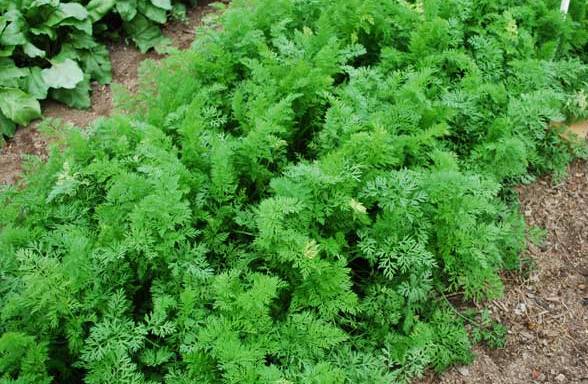
Introduction of Carrot Farming:- Carrot is one of the nutritious vegetable grown throughout the world. Commercial cultivation of carrot is successful in most of the regions. About 60% of world carrot production occurred in Asia alone. However, selecting quality seeds/seedlings and good farm management practices make the carrot production most successful. Carrots common to Asia have purple, pink, or red skins, with yellow or orange cores. Basically, carrots are biennial plants, grown as annuals. The first year, they store energy in their roots. Then the next spring, they leaf out quickly and send up a flower stalk. Carrots can be cultivated in both tropical and sub-tropical regions. Carrot belongs to the family of “Apiaceae” and genus of “Daucus “. Carrot is native to native to Europe and southwestern Asia. The most commonly eaten part of a carrot is a taproot, although the greens are sometimes eaten as well. Carrot has good health benefits as well. Let us discuss its growing conditions, planting methods and other factors involved in carrot farming. Carrots can be grown in pots, containers and protected environment like green house and polyhouse.
Health Benefits of Carrot:- The following are the health benefits of carrot.

- Carrot improves vision.
- Carrot helps prevent cancer.
- Carrot prevents infection.
- Carrot Promotes healthier skin.
- Carrot slows down aging due to anti-ageing properties.
- Carrot prevents heart disease.
- Carrot cleanses the body.
- Carrot prevents stroke.
- Carrot boosts the immune system.
- Carrot protects teeth and gums.
Local Names of Carrot in Asia:- แครอท (Thai), Gajar (Hindi, India), 당근 (Korean), Gaajar, गाजर (Nepali), Jazar, جزر (Arabic), 红萝卜 (Chinese), Karot (Filipino), Cà rốt (Vietnamese), にんじん, Nin jin (Japanese), කැරට් (Sinhalese, Sri Lanka), Gajar (Urdu), ការ៉ុត (Cambodian), havuç (Turkish), морко́вь (Russian), Angzhaethaau,胡萝卜 (Taiwanese), lobak merah (Malay).
Local Names of Carrot in India:- Gajar, गाजर (Hindi), கேரட் (Tamil), കാരറ്റ് (Malayalam), Gazor (Konkani), Gujara Gadda(Telugu), Gaajar (Gujarati), Gaa jer (Manipuri), Gajar (Oriya), Gaazor (Assamese), ಕ್ಯಾರೆಟ್ (Kanada), Gajar,गाजर (Marathi),ਗਾਜਰ (Punjabi), Gajar, গাজর (Bengali),Ghahzir (Kashmiri).
Varieties/ Kind of Carrots:- There are many varieties of carrots grown in Asia. Here are some of popular varieties of carrot grown in Asia; Tokita’s Scarlet, Mini Sweet, New Kuroda, Hybrid Sunrise Red, Hybrid Coral II. However, you should find out the suitable cultivar for your region and climatic conditions. Contact local horticulture or agriculture department or Agriculture University for high yielding commercial varieties.
Some of the Commercial Varieties of Carrots in India are as follows; Pusa Meghali, Pusa Rudhira, Pusa Asita, Pusa Vrishti, Nantes, Pusa Kesar, Pusa Yamdagni, Pusa Nayanjyoti, Hisar Gairic, Ooty-1, Early Nantes and New Korda.
Exotic Carrot Varieties: Exotic Varieties: Red Cored Chantenay, Danvers Half Long, Imperator, New Zealand – Akaroa Long Red, Spring Market Improved, Wanganui Giant, Japan-Suko, Belgium-Belgian White, France- Chantenay, Nantes, Oxheart, Touchon, Australia-Red Elephant, Yellow, Netherlands-Early Horn and Western Red.
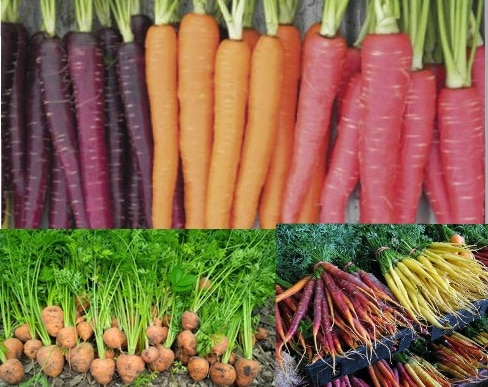
Soil Requirement for Carrot Farming:- Basically, carrot is a cool season crop and when grown at 15°C – 21°C will develop a good colour. The carrot crop requires deep loose loamy soil rich in organic matter with a pH ranging from 6.0 to 7.5 for higher yield.
Climate Requirement for Carrot Farming:- Basically, carrot is a cool season crop and can be cultivated under wide range of rain-fall conditions. The optimum temperature for seed germination is 6°C to 24°C where as 17°C to 24°C is ideal for better root growth. Very high and very low temperatures will impact the yield, quality of carrot.
Land Preparation in Carrot Farming:- The field should be thoroughly ploughed so that the clods do not interfere with the root development of carrots. Land should be prepared by giving 3 or 4 ploughings to bring the soil to fine tilth stage. Supplement the land with 25 tonnes/ha of well-rotten farm yard manure during last plough. This also takes care of any weeds from previous crops. Form raised beds of 1 meter breadth and convenient length in hills where as in plains; ridges and furrows should be formed at 30 cm distance.
Planting Methods and Season in Carrot Farming:- Carrot is a usually grown on ridge to facilitate good root development. The carrot seeds should be dibbled at 1.5 cm depth at a spacing of 30 cm x 8 cm. For enhancing germination, the seeds should be soaked in water for 12 to 24 hours before sowing in the field. The carrot crop is sown during January to February, June to July and October to November. In the mild climate, carrot can be grown almost throughout the year except few summer months.
Propagation and Seed Rate in Carrot Farming:- Propagation is done through seeds and the seed rate depends on the variety and region. On an average of 5 to 6 kg of seed /ha is required in carrot farming.
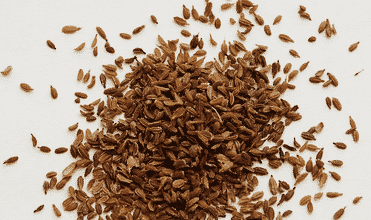
Seed treatment in Carrot Farming:- The following ways seeds can be treated before sowing in the garden.
- Carry out the seed treatment with cow pat pit @ 3 grams in 1 liter of water for 24 hours.
- Carry out the seed treatment with 5% of Trichoderma viride.
- Seedling root dip with 5% of Pseudomonas fluorescens before transplanting in the main filed.
Sowing and Spacing in Carrot Farming:- Prepare the rows with distance of 25 cm to 30 cm apart and sow the carrot seeds mixed with sand (Mix 1 part of seed with 4 parts of sand).
Manures and Fertilizers in Carrot Farming:- Well-rotten farm yard manure (FMY) of 30 to 35 tonnes should be applied during land preparation. This may be increased up to 50 tonnes/ha in case of organic carrot farming. The N:P:K of 90:90:90 kg/ha should be applied as basal dose and N:P:K of 45:45:45 kg/ha should be applied after 45 days of sowing the seeds. Applying 25 kg of ZnSO4 per ha as a basal also recommended.
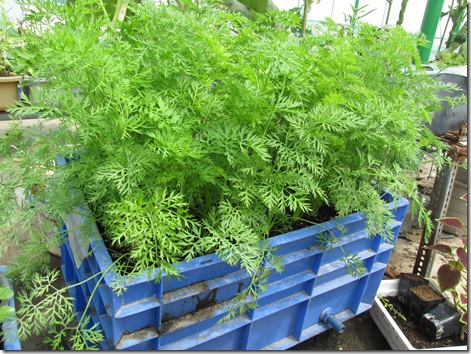
Irrigation in Carrot Farming:- Give light Irrigation while sowing the seeds in the field. On an average, it requires irrigation in 4 to 5 days interval. During drought periods, after giving irrigation in the evening, crop beds should be covered with wet gunny bags. This prevents water loss during hot climatic conditions. This also makes seeds to germinate quickly.
Intercultural operations in Carrot Farming:-
- Weeding in Carrot Farming:- Regular weeding will improve the plant growth and production. Spray weedicide of Fluchloralin 1 liter a.i./ha after sowing the seeds to control weeds or first weeding is to be done on 15th day after sowing.
- Thinning and Earthing in Carrot Farming: Thinning and earthling up should be given after 1 month of sowing.
Pests and Diseases in Carrot Farming:- Generally, carrots are not affected by any serious pests and diseases. However, the following should be carried out as control measures incase these pests and diseases occur in carrot plantation.
Pests:
Nematode: To control root knot nematode, apply neem cake @ 1 ton/ha at planting time.
Diseases:
Leaf spot: This can be controlled by Spraying Mancozeb at 2 grams/liter of water.
Bacterial blight: The bacterium causes irregular brown spot on leaves, dark brown streaks on petioles and a blighting of floral parts. Lesions on foliage begin as small yellow spots. Soon the centre of the spots they become dry and brittle with an irregular halo.
Control measures: Spraying early with Copper oxychloride 0.25 %.
Bacterial soft rot: The symptoms of this disease are: cells become water soaked, the middle lamella is destroyed and the cells collapse into a soft, watery slimy mass.
The rotted tissues are grey to brown. They may be accomplished by a foul odour.
The decay develops most rapidly along the core of the root.
Control measures: To control this disease, dip in a solution of 1:500 of sodium hypochlorite before storage.
Cercospora leaf spot: The first symptom usually appears as elongated lesions along the edge of the leaf. Non-marginal lesions appear as small, pin-point chlorotic spots which shows develop into a necrotic center surrounded by a diffuse chlorotic border.
Control measures: Seeds should be treated with Captan 4 grams /kg Spraying at 10 days interval with Copper oxychloride or Mancozeb.
Sclerotinia Rot or White mold: The following symptoms may occur with this: carrots may show little or no damage incidence in the field but following washing and storage white mold outbreaks often occur on the stored roots.
Control measures: Frequent inspection in storage, low temperatures, aeration and washing in a final water of 2 to 5 % of diluted bleach solution may control.
Harvesting in Carrot Farming:- The edible roots of carrot plant becomes ready for harvesting in about 3 to 4 months after sowing. Harvesting period depends on the variety. It is recommended to discontinue the irrigation 2 to 3 weeks before harvesting to increase the sweetness and taste. A light irrigation should be given a day before harvesting for lifting of roots. Carrot crop is harvested manually by uprooting each plant. Carrots for processing purpose should be left in the ground for a longer period. After harvesting, the green tops should be cut and the carrots should be separated and cleaned.
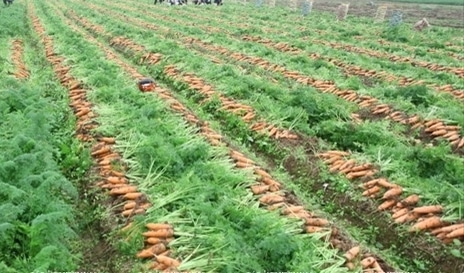
Yield in Carrot Farming:- Well, yield of any crop depends on many factors. With good cultivar (variety), soil, climatic conditions and finally farm management practices, 25 to 35 tonnes /ha can be achieved in 100 to 120 days.
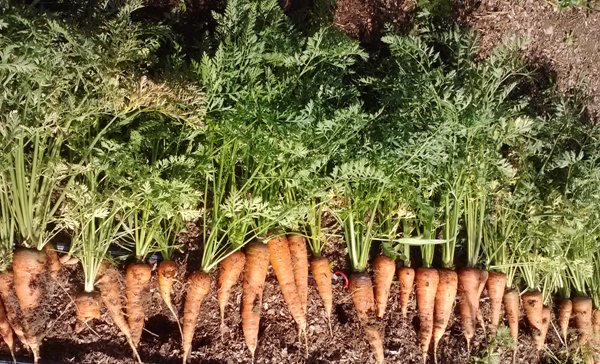
Post Harvesting in Carrot Farming:- Carrots should be graded based on their size and length. The carrots should ideally uniform in all aspects and similar shape for the variety, well formed, smooth, firm but of tender texture. It should also be free from harvest damage, decay or disease for best quality marketing. Marketing can be done on daily basis to local markets or can be packed for imports to long distance markets.
For Indian Agriculture : Read here.
For Sheep or Goat Farming: Read here.
